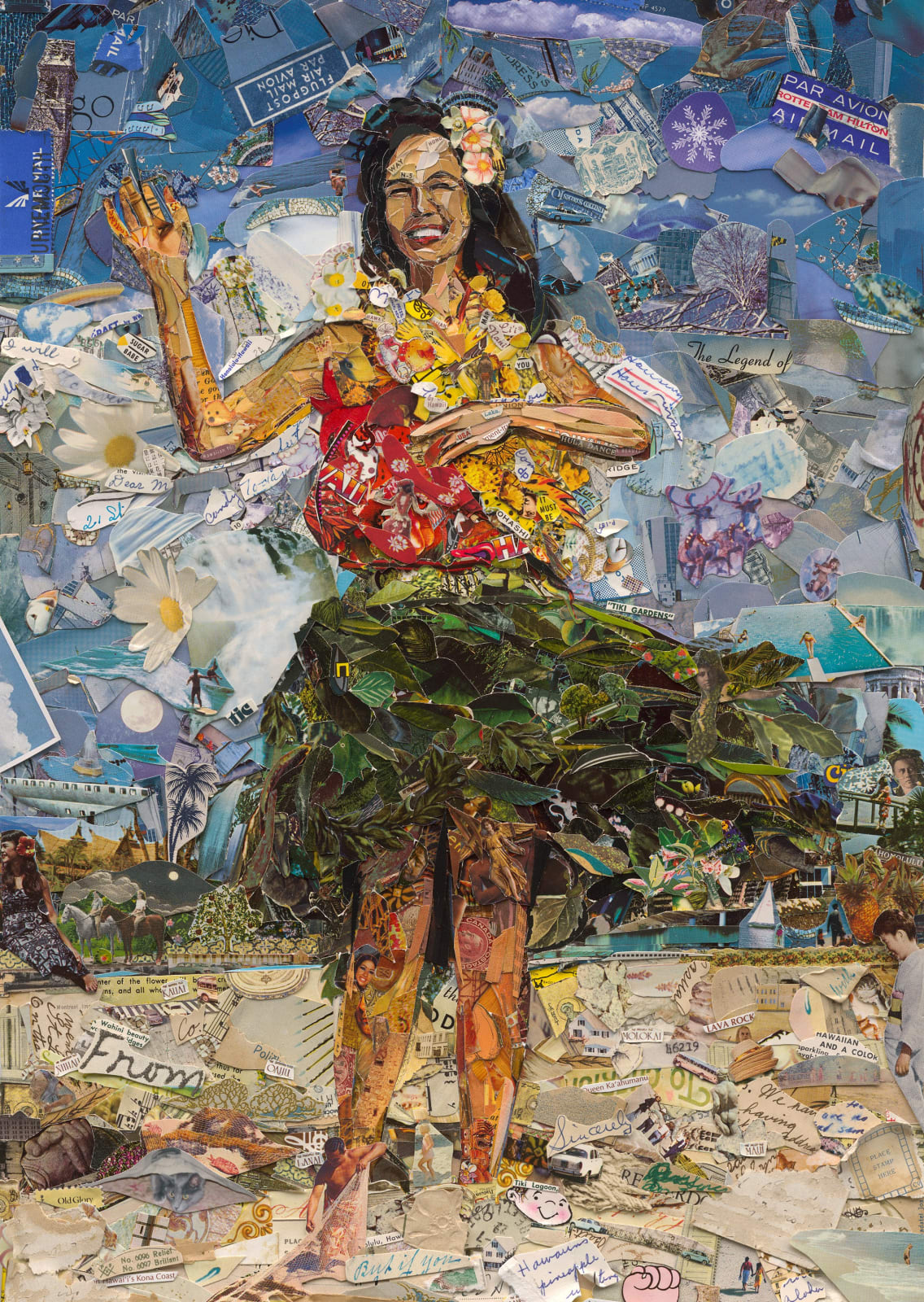
Vik Muniz Brazilian, 1961
Hula Dancer (Postcards from Nowhere), 2014
Digital C-print
143 x 101.6 cm; (56 1/4 x 40 in.)
Edition of 6 + 4 AP
Copyright The Artist
Further images
Vik Muniz’s series Postcards from Nowhere recreates iconic travel imagery through carefully assembled fragments of postcards. To make this series, the artist obsessively collected vintage photographs and postcards and then...
Vik Muniz’s series Postcards from Nowhere recreates iconic travel imagery through carefully assembled fragments of postcards. To make this series, the artist obsessively collected vintage photographs and postcards and then shredded and collaged these intimate relics to create bold new imagery magnified to a staggering scale. These collaged compositions are subsequently photographed, transforming ephemeral, tactile remnants into newly mediated images. Muniz’s reconstructions are conceptual meditations on memory, loss, and the evolving status of photography in an increasingly dematerialised, digital visual culture.
Muniz is interested in the history of sending and collecting postcards as a recollection of one’s travels and a form of communication, which has since been replaced by the instantaneous nature of modern technology. The thick format of the vintage photographs collaged together, coupled with the studio lighting used to photograph them, result in a three-dimensional, tactile quality in these monumental photographs. Muniz’s practice, long rooted in the transformation of everyday materials, here turns to the postcard, a once-intimate artefact of personal communication and physical travel. In an era where images are endlessly reproduced and circulated through digital platforms, the tactile, material specificity of the postcard has become obsolete. Postcards from Nowhere thus speaks to a broader cultural shift: the dematerialisation of visual experience and the erosion of ephemeral physical mementos in favour of digital images.
By repurposing fragments of postcards to depict the very sites they once commemorated, Muniz stages a meditation on the fragmented nature of contemporary visual culture. The compositions are not perfect panoramas but carefully disjointed constructions, echoing the disintegration of spatial memory in an age of oversaturation. Each work functions as both image and object, a visual echo assembled from the remnants of personal and collective pasts.
Postcards, as carriers of subjective experience, are used in the series to construct collective visions of place. Muniz collapses the boundary between individual remembrance and mass-produced imagery, prompting viewers to reconsider how memory is constructed, shared, and reinterpreted. By rendering familiar landmarks through an unconventional and increasingly anachronistic medium, Muniz explores how we perceive, circulate, and consume images in the 21st century.
Muniz is interested in the history of sending and collecting postcards as a recollection of one’s travels and a form of communication, which has since been replaced by the instantaneous nature of modern technology. The thick format of the vintage photographs collaged together, coupled with the studio lighting used to photograph them, result in a three-dimensional, tactile quality in these monumental photographs. Muniz’s practice, long rooted in the transformation of everyday materials, here turns to the postcard, a once-intimate artefact of personal communication and physical travel. In an era where images are endlessly reproduced and circulated through digital platforms, the tactile, material specificity of the postcard has become obsolete. Postcards from Nowhere thus speaks to a broader cultural shift: the dematerialisation of visual experience and the erosion of ephemeral physical mementos in favour of digital images.
By repurposing fragments of postcards to depict the very sites they once commemorated, Muniz stages a meditation on the fragmented nature of contemporary visual culture. The compositions are not perfect panoramas but carefully disjointed constructions, echoing the disintegration of spatial memory in an age of oversaturation. Each work functions as both image and object, a visual echo assembled from the remnants of personal and collective pasts.
Postcards, as carriers of subjective experience, are used in the series to construct collective visions of place. Muniz collapses the boundary between individual remembrance and mass-produced imagery, prompting viewers to reconsider how memory is constructed, shared, and reinterpreted. By rendering familiar landmarks through an unconventional and increasingly anachronistic medium, Muniz explores how we perceive, circulate, and consume images in the 21st century.
